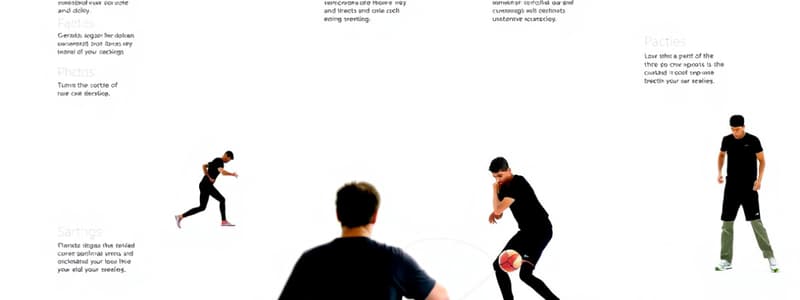Podcast
Questions and Answers
What is the purpose of using training wheels or parallel bars in training?
What is the purpose of using training wheels or parallel bars in training?
- To enhance social interaction during practice
- To help maintain balanced movement (correct)
- To increase the complexity of the skill quickly
- To allow learners to practice in an open environment
How does changing the complexity of the environment help learners?
How does changing the complexity of the environment help learners?
- It reduces competition among learners
- It eliminates the need for skill practice
- It increases the physical demands of the task
- It decreases attentional demands (correct)
Which of the following activities serves to simplify skills in a controlled environment?
Which of the following activities serves to simplify skills in a controlled environment?
- CrossFit training
- Powerlifting
- Kickball (correct)
- Solo running
What does sequencing from simple to complex involve?
What does sequencing from simple to complex involve?
How is progressive complexity achieved in skill training?
How is progressive complexity achieved in skill training?
What example is given for starting a baseball or softball skill practice?
What example is given for starting a baseball or softball skill practice?
What is attention cueing in practice methods?
What is attention cueing in practice methods?
What is NOT a tactic for introducing complexity in exercises?
What is NOT a tactic for introducing complexity in exercises?
Flashcards
Maintaining Underlying Dynamics
Maintaining Underlying Dynamics
Training methods that help maintain balanced movement in skill development by using aids like training wheels, parallel bars, and adjustable tools like Swiss balls.
Simplifying Movement
Simplifying Movement
Adjusting the exercise environment to lessen the attention required for learning, making the task less complicated.
Skill-Building Activities
Skill-Building Activities
Activities that help learners practice skills in a controlled, simplified environment to build and apply new skills progressively.
Sequencing from Simple to Complex
Sequencing from Simple to Complex
Signup and view all the flashcards
Progressive Complexity
Progressive Complexity
Signup and view all the flashcards
Attention Cueing
Attention Cueing
Signup and view all the flashcards
Simplified Skill Practice
Simplified Skill Practice
Signup and view all the flashcards
Progressively Increasing Difficulty
Progressively Increasing Difficulty
Signup and view all the flashcards
Study Notes
Principles of Practice Design
- Skills can be broken down into smaller parts and practiced in isolation
- Learners can begin with simpler versions of a skill and gradually increase complexity
- The environment can be controlled and adjusted to reduce the demands on learners
- Lead-up games and activities can help learners learn new skills in a safe environment
- Skill progression should have a clear sequence from basic to advanced
- Increasing the difficulty of a skill progressively develops learners’ abilities
- Modifying the complexity or simplicity of the environment creates a skill progression
- Simplifying skills and focusing on smaller components makes mastering them easier
- Providing learners with different support may assist in mastering skills
- A well-structured sequence aids in developing progressively more challenging skills
- Gentile's taxonomy can be used as a resource for designing simple to complex progressions
Attention Cueing
- A practice option that combines the benefits of part and whole practice
- Learners direct attention to a specific aspect of a skill during practice
Studying That Suits You
Use AI to generate personalized quizzes and flashcards to suit your learning preferences.



